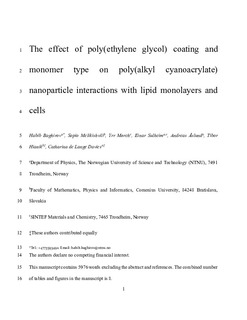| dc.contributor.author | Baghirov, Habib | |
| dc.contributor.author | Melikishvili, Sopio | |
| dc.contributor.author | Mørch, Yrr Asbjørg | |
| dc.contributor.author | Sulheim, Einar | |
| dc.contributor.author | Åslund, Andreas | |
| dc.contributor.author | Hianik, Tibor | |
| dc.contributor.author | Davies, Ruth Catharina de Lange | |
| dc.date.accessioned | 2017-10-25T06:58:28Z | |
| dc.date.available | 2017-10-25T06:58:28Z | |
| dc.date.created | 2017-06-14T14:13:42Z | |
| dc.date.issued | 2017 | |
| dc.identifier.citation | Colloids and Surfaces B: Biointerfaces. 2017, 150 373-383. | nb_NO |
| dc.identifier.issn | 0927-7765 | |
| dc.identifier.uri | http://hdl.handle.net/11250/2461990 | |
| dc.description.abstract | The interaction of the promising drug carriers poly(alkyl cyanoacrylate) nanoparticles (PACA NPs) with lipid monolayers modeling the cell membrane and with RBE4 immortalized rat brain endothelial cells was compared to assess the relevance of lipid monolayer-based cell membrane models for PACA NP cellular uptake. NP properties such as size and charge of NPs and density of poly(ethylene glycol) coating (PEG) were kept in a narrow range to assess whether the type of PEG coating and the PACA monomer affected NP-monolayer and NP-cell interactions.
The interaction with lipid monolayers was evaluated using surface pressure measurements and Brewster angle microscopy. NP association with and uptake by cells were assessed using flow cytometry and confocal laser scanning microscopy.
The interaction between NPs and both lipid monolayers and the plasma membrane depended on the type of PEG. PEG density affected cellular uptake but not interaction with lipid monolayers. NP monomer, NPs size and charge had no effect on the interaction. This might be due to the fact that the size and charge distribution was kept rather narrow to study the effect of PACA monomer and PEG type.
In conclusion, while modeling solely the passive aspect of NP-cell interactions, lipid monolayers nevertheless proved a valuable cell membrane model whose interaction with PACA NPs correlated well with NP-cell interaction. In addition, both NP-monolayer and NP-cell interactions were dependent on PEGylation type, which could be used in the design of NPs to either facilitate or hinder cellular uptake, depending on the intended purpose. | nb_NO |
| dc.language.iso | eng | nb_NO |
| dc.publisher | Elsevier | nb_NO |
| dc.title | The effect of poly(ethylene glycol) coating and monomer type on poly(alkyl cyanoacrylate) nanoparticle interactions with lipid monolayers and cells | nb_NO |
| dc.type | Journal article | nb_NO |
| dc.description.version | submittedVersion | nb_NO |
| dc.source.pagenumber | 373-383 | nb_NO |
| dc.source.volume | 150 | nb_NO |
| dc.source.journal | Colloids and Surfaces B: Biointerfaces | nb_NO |
| dc.identifier.doi | 10.1016/j.colsurfb.2016.10.051 | |
| dc.identifier.cristin | 1476084 | |
| dc.relation.project | Norges forskningsråd: 220005 | nb_NO |
| dc.description.localcode | This is a submitted manuscript of an article published by Elsevier Ltd in Colloids and Surfaces B: Biointerfaces, 31 October 2016. | nb_NO |
| cristin.unitcode | 194,66,20,0 | |
| cristin.unitname | Institutt for fysikk | |
| cristin.ispublished | true | |
| cristin.fulltext | preprint | |
| cristin.qualitycode | 1 | |
